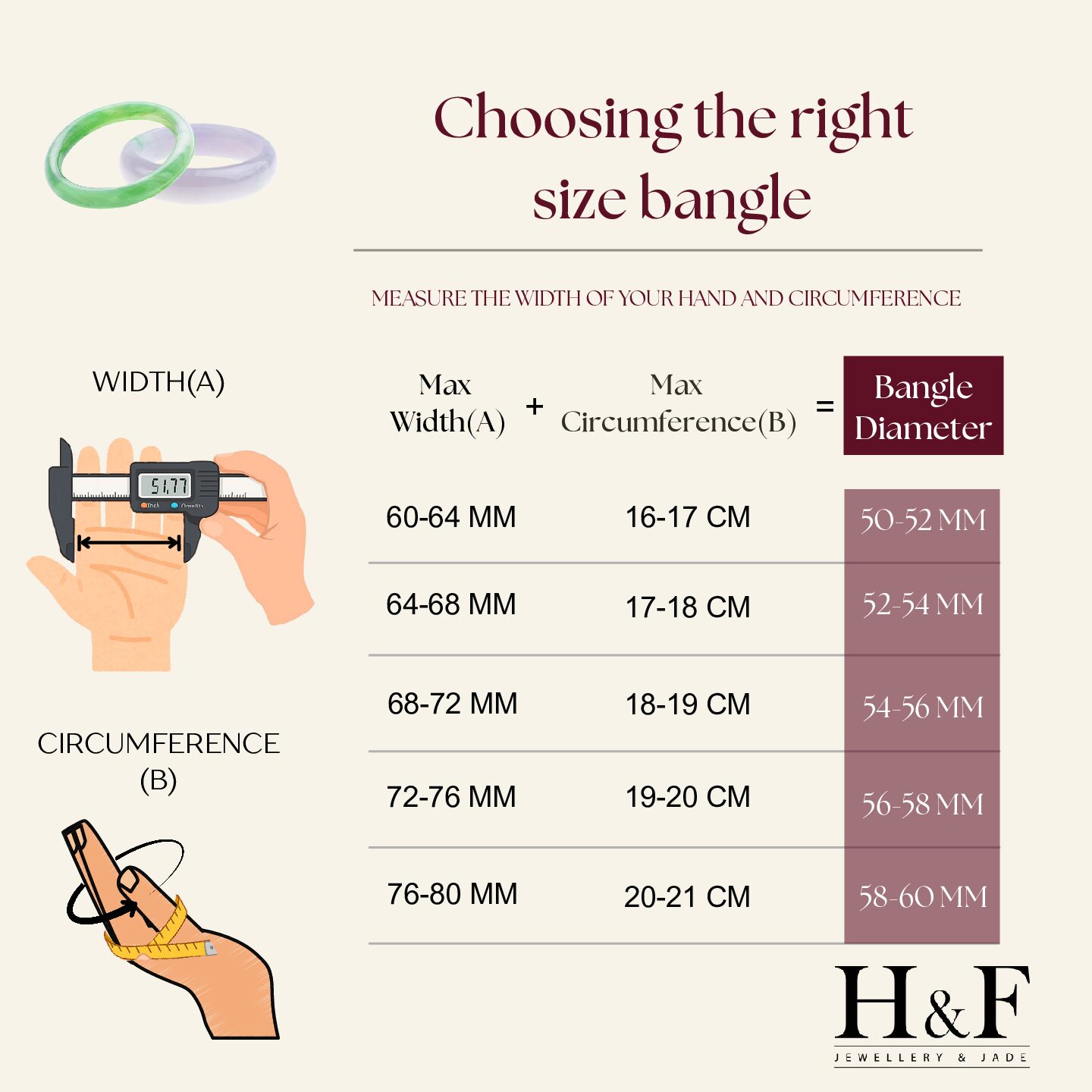Definition of Type A, B, C Jadeite Jade
Type A, B, C are trade terms commonly used for Jadeite in the jade industry, not representative of jadeite grading.
Jade includes Nephrite and Jadeite. Myanmar (Burma) is the major source of Jadeite.
H&F Jewellery and Jade ONLY sell TYPE A NATURAL JADEITE JADE
Type A – Natural Jadeite Jade
Refers to natural jadeite which is not subject to any form of chemical treatment except those traditional processes as plum juice washing and wax polishing. These procedures are internationally recognized as standard practice and are not defined as “treatment” because the structure of jadeite has not been damaged.
Type B – Chemically bleached and polymer impregnated Jadeite Jade
Refers to stones which have been chemically bleached to remove impurities. It is further rinsed with caustic soda and followed by impregnation of polymer to enhance translucency. The structure of jadeite is damaged through this treatment and will lose its luster once the polymer deteriorates in several years. In addition, type B jadeite jade cannot withstand heat and pressure.
Type C – Dye colored Jadeite Jade
Jadeite of this kind are usually colorless or of very faint tone, which are therefore dyed to enhance its brightness. However, such artificial hue will gradually fade out with the lapse of time.
Type B plus C – Dye colored and polymer impregnated Jadeite Jade
Refers to type B which has also been dyed to enhance its translucency and brightness during the polymer impregnation process.
How to Measure your Bangle Size

Diamonds
4Cs
Diamond Color, Clarity, Cut and Carat Weight are collectively termed the 4Cs – the factors that, when combined, define a diamond’s quality and ultimately determine its value. GIA created the 4Cs of Diamond Quality, which has become the universal method for assessing the quality of any diamond, anywhere in the world. The creation of the 4Cs means that diamond quality can be communicated in a universal language so diamond purchasers know exactly what they are buying.
Color
GIA’s diamond color grading system measures the absence of color, starting with D as colorless and continuing to Z representing light yellow or brown. The distinctions between color grades are so subtle that they are often invisible to the untrained eye but can make a big difference in diamond quality and price.
Cut
A diamond’s cut determines its sparkle. To fashion a stone with proportions, symmetry and polish worthy of an excellent cut grade requires artistry and workmanship. The finer the cut quality, the more sparkle the diamond has.
Clarity
Natural diamonds form from carbon exposed to tremendous heat and pressure deep in the earth. Diamonds often contain clarity characteristics, called inclusions or blemishes. Inclusions are enclosed within the gem and blemishes are on the surface of the diamond. If all else is equal, the closer a diamond is to flawless, with no inclusions or blemishes, the higher its value.
Carat Weight
Diamond weight is measured in carats. One carat is equal to 0.2 gram, about as heavy as a paperclip. Since larger diamonds are more rare, they will cost more than a smaller gem with the same color, clarity and cut grades.
Diamond Fluorescence
Fluorescence is the visible light some diamonds emit when they are exposed to invisible ultraviolet (UV) rays. On a GIA diamond grading report, fluorescence refers to the strength, or intensity, of the diamond’s reaction to long- wave UV, which is an essential component of daylight. The light emitted lasts as long as the diamond is exposed to the ultraviolet source.
Diamond Treatments
While treatments can improve a stone’s Color or Clarity, the presence of such enhancements may affect the diamond’s value – particularly if the price reflects its appearance after treatment. Buyers have a right to know whether a stone is natural, a diamond simulant or a diamond created in a lab, and whether or not the stone has been treated to enhance its appearance.
Diamond Simulants
While the appearance of diamond simulants is similar to that of natural diamonds, they are not diamonds. Common diamond simulants include glass and cubic zirconia (CZ), both of which are completely unrelated to diamond at the atomic level. Simulants are generally less expensive than the real thing. They allow consumers to enjoy the flash and dazzle of diamond-like jewelry and to inexpensively complement the latest fashion trend. But no matter how convincing the illusion, all diamond simulants have optical and physical characteristics that can be identified by a trained gemologist.
Laboratory-grown diamonds
A lab-grown diamond (sometimes called man-made or synthetic diamond) is the result of a technological process, as opposed to the geological process that creates natural diamonds. Lab-grown diamonds have essentially the same chemical composition, crystal structure, optical and physical properties of diamonds found in nature. Most lab-grown diamonds are categorized as either high-pressure, high-temperature (HPHT) or chemical vapor deposition (CVD) diamonds, depending on the method of their production. Since HPHT and CVD diamonds grown in a laboratory are virtually identical to natural diamonds, differences only become clear when they are analyzed in a gem laboratory.
How to care for your diamond
Diamonds are remarkably durable, resist scratching (except by other diamonds) and maintain their brilliance over time. But diamonds aren’t indestructible. They can be chipped by a sharp blow, become loose or lost in a weakened setting, or be damaged by contact with other diamonds. Wear diamond jewelry with care. Store it in padded boxes or soft bags separate from other jewelry. Clean your jewelry by wiping it with a lint-free cloth or with warm water, mild soap and a soft toothbrush, or by dipping it briefly in a commercial cleaning solution. Have your diamond jewelry periodically cleaned and its setting examined by a professional jeweler to maintain its beauty and integrity over time.
Choosing an engagement ring
1. Know what you want to spend.
You will be confronted with a dizzying array of choices when it comes to engagement rings. Have a price range in mind. Going in with fairly specific parameters will help your jeweler find the right engagement ring to fit your budget.
2. Know her ring size
If she wears rings, borrow one she already owns. Trace the inner circle on a piece of paper, or press the ring into a bar of soap for an impression. You can also slide it down one of your own fingers and draw a line where it stops. A jeweler can use these measurements to identify her approximate ring size. If she doesn’t wear rings, estimate in the following manner: The average ring size in the US is 6 (based on the ‘average’ US female being 5’4” tall and weighing 140 lbs.) If she’s more slender, or fine boned, her ring size is probably in the 4 1/2 to 5 1/2 range. If she is heavier, larger boned or taller, her ring size is probably in the 6 1/2 to 7 1/2 range. It’s always better to buy a ring a bit bigger than you think she’ll need, because sizing a ring down is much easier than increasing its size.
3. Know what diamond shape suits her
She will be wearing this ring every day of your married life. It will need to go with everything from jeans to eveningwear. If you’re uncertain about her shape preference, it’s sensible to stick to the classics. They became classics because they appeal to most people most of the time. Certain shapes pair more successfully with other gems in multi-stone rings. Round, Oval and Marquise all work well. If she prefers clean, modern lines in furniture, for example, it’s likely she’ll react well to the same aesthetic in Rectangular or Square shapes, like the Emerald Cut or Princess Cut. If she tends towards the traditional, a round shape rarely misses.
4. Know what setting makes sense
There are four basic types you are likely to encounter: solitaire, side stone, three stone and pavé. As to actual setting design, consider her lifestyle and how well a certain setting will fit into it. If she’s more active or outdoorsy, look for lower profile, less ornate, more sturdy choices, which are less likely to get knocked or caught on things. If she’s more of a glamour girl, look for statement settings, with a higher stone profile and more intricate ring detailing or unique motif.
I am text block. Click edit button to change this text. Lorem ipsum dolor sit amet, consectetur adipiscing elit. Ut elit tellus, luctus nec ullamcorper mattis, pulvinar dapibus leo.
